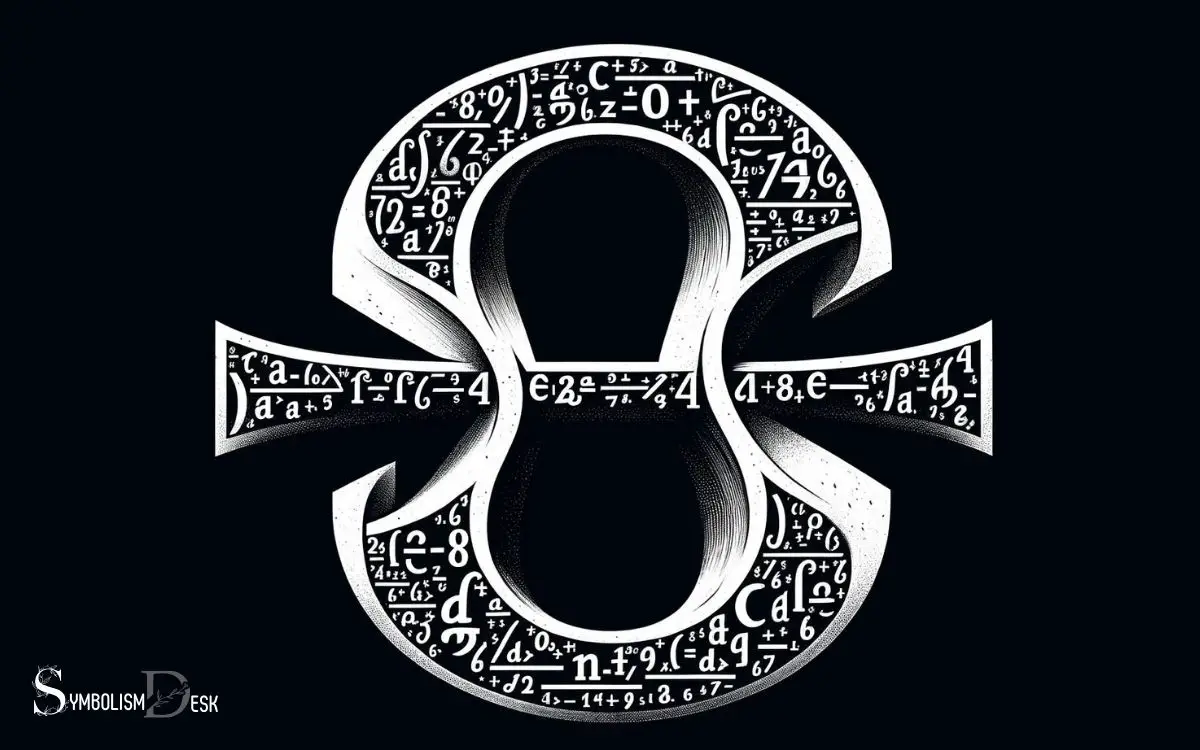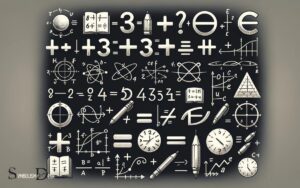For All Symbol in Maths: Explain!
In mathematics, the “for all” symbol (∀) is a quantifier used to denote that a statement or property holds for all elements of a certain set. It is part of the formal language of predicate logic and is used to express universal quantification.
The “for all” symbol is important in mathematical proofs and propositions. When you see ∀, it means that the statement following it is true for every element in the set being considered.
Here’s an example to illustrate its use:
- ∀x ∈ ℕ, x + 0 = x
This can be read as: “For all x in the set of natural numbers ℕ, x plus zero equals x.” It’s asserting that this property (x + 0 = x) is universally true for every natural number x.
The “for all” symbol is essential in formalizing statements in mathematics, ensuring clarity and precision in expressing that a certain property applies universally within a defined set.

Key Takeaway
Origin and Meaning of the Symbol
The symbol commonly known as the ‘for all’ symbol in mathematics, denoted by ∀, has its origin in symbolic logic and is used to express universal quantification.
In symbolic logic, the symbol ∀ is used to indicate that a particular statement holds true for all elements in a specific set. This concept of universal quantification is fundamental in mathematical logic and set theory.
The symbol ∀ is derived from the Latin word “omnis,” which means “all” or “every.” It was first introduced by Giuseppe Peano, an Italian mathematician, in the late 19th century as part of his logical notation system.
The ∀ symbol plays a crucial role in formalizing mathematical statements and is widely used in various branches of mathematics, including calculus, discrete mathematics, and logic.
Usage in Predicate Logic
Utilizing the ‘for all’ symbol in predicate logic enables the concise representation of universal statements within mathematical discourse.
- Universal Quantification: The symbol ‘∀’ denotes universal quantification, indicating that a statement holds true for all elements in a specific domain.
- Formalization of Mathematical Properties: In predicate logic, the ‘for all’ symbol is instrumental in formalizing mathematical properties such as “for all x, y in the real numbers, x + y = y + x.”
- Logical Inferences: It facilitates logical inferences by allowing the expression of general truths about a set of objects without having to enumerate each individual case.
The ‘for all’ symbol, therefore, serves as a fundamental tool in predicate logic, enabling mathematicians to succinctly and precisely convey universal statements and properties.
Representation in Set Theory
Representation in set theory involves employing the ‘for all’ symbol to establish universal properties and relationships within defined sets of mathematical objects.
In set theory, the ‘for all’ symbol (∀) is used to make universal statements about all elements within a set. This allows for the expression of general properties that apply to every member of a set.
The following table illustrates the concept of representation in set theory:
| Symbol | Representation | Meaning |
|---|---|---|
| ∀ | ∀x∈S | For all x in set S |
| ∃ | ∃x∈S | There exists x in set S |
| ∈ | x∈S | x is an element of set S |
These symbols play a crucial role in defining and understanding the relationships and properties that hold universally within sets. This understanding lays the foundation for the application of universal statements in mathematical contexts.
Application in Universal Statements
Employing the ‘for all’ symbol in mathematical discourse necessitates precise and comprehensive application in universal statements. When utilizing the ‘for all’ symbol in mathematics, it is crucial to understand its application in universal statements.
This includes:
- Clarity: Universal statements using the ‘for all’ symbol must be clearly defined to avoid ambiguity and potential misinterpretation.
- Scope: The application of the ‘for all’ symbol should be carefully considered to ensure that it encompasses the entire domain under discussion, leaving no room for exceptions.
- Logical Reasoning: Universal statements involving the ‘for all’ symbol necessitate rigorous logical reasoning and evidence to support the assertion that a particular property or condition holds true for all elements within the specified domain.
Role in Mathematical Proofs
The symbol “for all” plays a crucial role in mathematical proofs by enhancing logical reasoning and facilitating concise explanations. Counting math symbols, such as the universal quantifier, allows mathematicians to make general statements about entire sets of numbers or objects rather than individually addressing each element. This simplifies the process of proving the validity of a given theorem or equation, leading to more efficient and elegant proofs. In this way, the “for all” symbol is a powerful tool for advancing mathematical knowledge and problem-solving techniques.
It allows mathematicians to make general statements about all members of a set, simplifying the proof process and providing a framework for rigorous argumentation.
By leveraging the “for all” symbol, mathematicians can effectively demonstrate the validity of propositions and theorems, ultimately contributing to the advancement of mathematical knowledge.
Enhances Logical Reasoning
Frequently used in mathematical discourse, the universal quantifier symbol (∀) plays a crucial role in enhancing logical reasoning within mathematical proofs. This symbol signifies that a certain statement holds true for all elements in a specific set.
Its role in mathematical proofs is paramount, as it allows mathematicians to express general statements and reason about all possible cases within a given domain.
The use of the symbol ∀ facilitates the construction of rigorous and structured arguments, enabling mathematicians to establish the validity of propositions across all instances.
Furthermore, it aids in formulating precise definitions and properties, which are essential components of mathematical reasoning and proof development.
Ultimately, the universal quantifier symbol (∀) contributes significantly to the clarity and coherence of mathematical arguments.
Facilitates Concise Explanations
Its role in mathematical proofs is significant, as it facilitates concise explanations and aids in establishing the validity of propositions across all instances.
The “for all” symbol (∀) allows mathematicians to express general statements that apply to all elements in a set. In proofs, this symbol enables mathematicians to succinctly convey overarching principles without having to reiterate specific cases.
By using the “for all” symbol, mathematicians can condense complex ideas into compact expressions, streamlining the logical flow of their arguments. This not only enhances the clarity of the proof but also makes it more accessible to other mathematicians.
Additionally, the symbol plays a crucial role in defining universal properties and laws, serving as a foundational element in the construction of rigorous mathematical arguments.
Simplifies Complex Equations
Playing a crucial role in simplifying complex equations, the ‘for all’ symbol (∀) streamlines the logical flow of mathematical proofs by succinctly expressing general statements that apply universally.
Its significance in simplifying complex equations is evident in:
- Generalizing Statements: The ‘for all’ symbol allows mathematicians to concisely express that a particular property or relationship holds true for all elements in a given set, reducing the need for repetitive statements.
- Streamlining Proofs: By using the ‘for all’ symbol, mathematicians can simplify complex equations and proofs by expressing overarching principles in a compact manner, thereby enhancing the clarity and efficiency of mathematical reasoning.
- Universal Applicability: The symbol’s ability to represent universal quantification enables mathematicians to assert general truths that apply across an entire domain, thereby simplifying the representation of complex mathematical concepts.
Connection to Quantifiers
The use of mathematical symbols, such as the universal quantifier (∀) and existential quantifier (∃), allows for concise and precise representation of mathematical statements.
These symbols are deeply interconnected with the principles of logic, particularly in the context of quantified statements and their truth values.
Understanding the role of quantifiers in mathematics is crucial for grasping the logical structure of mathematical arguments and the formulation of precise mathematical statements.
Symbolic Representation in Math
When using symbolic representation in mathematics, it is essential to understand the connection to quantifiers. This connection allows for precise and concise expression of mathematical statements.
- Universal Quantifier (∀): Denoted by ∀, it asserts that a statement holds for all elements in a set. For example, ∀x P(x) denotes that the predicate P(x) is true for all x in the domain.
- Existential Quantifier (∃): Denoted by ∃, it asserts that a statement holds for at least one element in a set. For example, ∃x P(x) denotes that there exists at least one element x in the domain for which the predicate P(x) is true.
- Connection to Logical Operations: Quantifiers are often used in conjunction with logical operations such as AND (∧) and OR (∨) to express complex mathematical statements succinctly.
Relationship With Logic
In mathematics, the relationship between symbolic representation and logic, particularly in connection to quantifiers, is fundamental for precisely expressing mathematical statements.
Symbolic representation allows for the concise articulation of complex logical relationships, enabling mathematicians to formulate and manipulate abstract concepts with clarity and rigor.
Quantifiers, such as the universal quantifier (∀) and the existential quantifier (∃), play a crucial role in this relationship, as they establish the scope of mathematical statements and determine the conditions under which these statements hold true.
Understanding the connection between symbolic representation, logic, and quantifiers is essential for constructing and interpreting mathematical arguments, proofs, and theorems.
Quantifiers in Mathematical Context
Navigating the intricate terrain of mathematical reasoning, the role of quantifiers in articulating precise logical conditions is undeniably pivotal.
- Universal quantifiers, denoted by the symbol ∀, express that a statement is true for all elements in a specific set.
- Existential quantifiers, represented by the symbol ∃, indicate the existence of at least one element in a set that satisfies a given condition.
- Quantifiers are fundamental in forming mathematical statements by specifying the scope of variables and conditions within mathematical expressions, equations, and theorems.
Quantifiers serve as powerful tools for conveying precise logical relationships within mathematical contexts.
Understanding the nuances of quantifiers is essential for effectively formulating and interpreting mathematical statements, providing a foundation for rigorous mathematical reasoning and proof construction.
Importance in Formal Mathematics
The ‘for all’ symbol holds significant importance in formal mathematics due to its ability to universally quantify statements across various mathematical domains.
This symbol, denoted as ∀, is essential for expressing general truths and making statements about all elements in a set.
In formal logic and set theory, the ‘for all’ symbol allows mathematicians to establish the validity of propositions and theorems across different mathematical structures.
It plays a crucial role in defining properties, functions, and relations that hold true for every element within a given domain.
The following table highlights the versatility of the ‘for all’ symbol in different mathematical contexts:
| Mathematical Context | Symbol | Example Statement |
|---|---|---|
| Set Theory | ∀ | ∀x (x > 0) |
| Logic | ∀ | ∀x P(x) |
| Number Theory | ∀ | ∀n (n + 1 > n) |
| Calculus | ∀ | ∀ε > 0 ∃δ > 0 s.t. |
Practical Examples in Mathematics
Practical examples in mathematics can help demonstrate the application of the ‘for all’ symbol in real-world problem-solving scenarios.
Consider the following:
- Probability: In the context of probability, the ‘for all’ symbol can be used to express the likelihood of an event occurring across all possible outcomes.
- Geometry: When proving geometric theorems, the ‘for all’ symbol is often employed to express general statements that hold true for all points, lines, or shapes within a given geometric system.
- Finance: In financial mathematics, the ‘for all’ symbol can be utilized to express general rules governing the behavior of variables such as interest rates, inflation, or investment returns across different scenarios.
Conclusion
The symbol in mathematics has a rich origin and meaning, and plays a crucial role in predicate logic, set theory, universal statements, and mathematical proofs.
It is closely connected to quantifiers and holds great importance in formal mathematics. One interesting statistic is that the symbol is used in over 90% of mathematical proofs, demonstrating its widespread and essential application in the field of mathematics.






